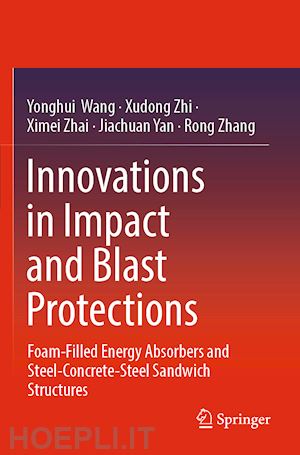
Questo prodotto usufruisce delle SPEDIZIONI GRATIS
selezionando l'opzione Corriere Veloce in fase di ordine.
Pagabile anche con Carta della cultura giovani e del merito, 18App Bonus Cultura e Carta del Docente
This book develops several novel foam-filled structures and steel-concrete-steel (SCS) sandwich structures, which provides more alternatives for ensuring the safety of buildings and infrastructures under extreme loading, like impact and blast. In the first part of this book, the aluminium foam- and polyurethane foam-filled structures have been developed for dissipating impact and blast energy. Experimental and numerical studies have been conducted to obtain their behaviours under impact loading. In addition, analytical models have also been proposed to assess their energy absorption performances and facilitate the impact and blast design when using the proposed foam-filled structures. In the second part of this book, SCS sandwich structures with novel shear connectors have been developed and their behaviours under impact and blast loading have been experimentally, numerically and analytical studied. Analytical models for predicting the impact and blast responses of SCS sandwich structures have also been developed. In the third part of this book, a new steel-polyurethane foam-steel-concrete-steel (SPUFSCS) panel (i.e. the combination of foam material and SCS panel) has been developed to achieve a higher impact resistant capacity. Owing to the increasing impact and blast threats on buildings and infrastructures, the studies presented in this book are of significant importance for providing several new solutions for impact and blast enhancement.
Aluminium foam-filled energy absorption connectors under impact.- Polyurethane foam-filled energy absorption connectors under impact.- Aluminium foam-filled nested tubes under impact.- Flat Steel-Concrete-Steel sandwich beams/panels under impact and blast.- Curved Steel-Concrete-Steel sandwich shells under impact and blast.- Steel-PU foam-Steel-Concrete-Steel panel under impact.
Dr. Yonghui Wang is an associate professor in the School of Civil Engineering, Harbin Institute of Technology, China. Dr. Wang received his Ph.D. degree from National University of Singapore in 2015 and thereafter worked as Research Fellow at National University of Singapore from 2015 to 2016. Dr. Wang joined Harbin Institute of Technology as a lecturer in 2016 and was promoted to an associate professor in 2018.
His current research interests are focused on the protection of structures against impact and blast loadings. Dr. Wang has published more than 50 peer-reviewed international journal papers. He has received 7 research funds, including National Natural Science Foundation of China, China Postdoctoral Science Foundation, Heilongjiang Postdoctoral Science Foundation, and the Fundamental Research Funds for the Central Universities, etc. Dr. Wang is the editorial board of “American Journal of Civil Engineering”, “Journal of Modern Industry and Manufacturing” and “Urban Construction Theory Research Journal”. He was conferred the Science and Technology Award of Heilongjiang Province (first class). Dr. Wang currently serves as the member of council in Aluminium Structure Branch of China Construction Metal Structure Association and the member of International Association of Protective Structures.











Il sito utilizza cookie ed altri strumenti di tracciamento che raccolgono informazioni dal dispositivo dell’utente. Oltre ai cookie tecnici ed analitici aggregati, strettamente necessari per il funzionamento di questo sito web, previo consenso dell’utente possono essere installati cookie di profilazione e marketing e cookie dei social media. Cliccando su “Accetto tutti i cookie” saranno attivate tutte le categorie di cookie. Per accettare solo deterninate categorie di cookie, cliccare invece su “Impostazioni cookie”. Chiudendo il banner o continuando a navigare saranno installati solo cookie tecnici. Per maggiori dettagli, consultare la Cookie Policy.